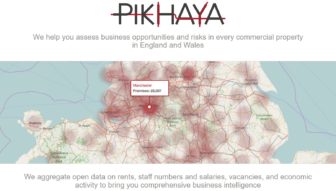

Meet the Man Who Filed 1,400 FOI Requests to Prove Data Acquisition Isn’t Terrorism
For the last three years Gavin Chait has been fighting — and winning — multiple freedom of information (FOI) cases to unlock data on vacant properties in England and Wales. Here’s how he used a range of evidence to fight a widely misused exemption.
I don’t know how to break this to you, but you’re probably a terrorist.
According to Richard Woolford, the strategic director of Security and Counter Terrorism with the City of London Corporation, unoccupied properties — and especially unoccupied commercial properties — are attractive for those intent on committing terrorism.
Any knowledge about vacant properties is so dangerous that no information about them should be placed in the public domain.
Estate Agents Against Terrorism
This will come as tough news to terrorism enablers, especially real-estate agents, property developers, banks, insurers and Google Street View.
If you were hoping to find somewhere new to live, or somewhere to open your dream business, then – for the safety of everyone – you’ll need to stay put.
At least, that’s the claim from City of London to my FOI request for a list of all commercial ratepayers, including information on their state of occupation.
Twenty years ago I was sitting with a client at his home in Gugulethu, a suburb of Cape Town, South Africa. We were discussing ways in which he could improve his small business. His home was a tiny single room in one of the old migrant-worker hostels from the apartheid-era. Rain dripped down on us through the rusted corrugated-iron roof, onto a large single bed he shared with his wife and onto the floor where his children slept. The door was open to let in light, for there were no windows, and there was only one tiny light bulb hanging from the ceiling. Outside, a woman bathed her child in a large zinc basin in the communal washing area.
We needed to fix his pricing and understand his market because – for him – consulting wasn’t a nice-to-have, but a matter of survival. And, I wondered, isn’t there a better, cheaper, way to assemble the information we need to get this right?
Three years ago, having moved to the UK and gotten deeply involved in the open data community, I began building a database that would contain commercial information on every business location in England and Wales.
For each property, I would have estimated rent, rates, staff numbers and costs, potential revenue and a comprehensive history of occupation and vacancy.
Anyone starting a business would have a ready resource to quickly assess what they could afford, what they could earn and how successful previous occupants of that site had been.

Property Business: Gavin Chait created a website for comprehensive data on business properties. Screenshot
I called the product Pikhaya.com.
Most of the data I wanted was available from large public repositories, including the Valuations Office Agency, responsible for rating all properties.
Occupation history, however, had to be secured from each local authority independently. And so I came to know the Freedom of Information Act, a task made accessible only because of WhatDoTheyKnow’s platform for sending FOIs.
And I came to know Section 31(1)(a) of that act.
FOI’s Section 31 Exemption
According to the Information Commissioner’s commentary:
“Section 31 is a prejudice based exemption and is subject to the public interest test. This means that not only does the information have to prejudice one of the purposes listed, but, before the information can be withheld, the public interest in preventing that prejudice must outweigh the public interest in disclosure.”
Section 31(1)(a) deals specifically with “the prevention or detection of crime.”
In 2011, the Information Tribunal declared in “Yiannis Voyias v Information Commissioner and London Borough of Camden” that releasing residential vacancy data would prejudice the prevention and detection of crime.
No evidence was presented during that case and the tribunal relied on witness opinions, mostly anecdotal tales of the “I heard, it’s been told…” variety.
One in Five Councils Published Vacancy Data
When I started my research in early 2016, 70 out of 348 local authorities in England and Wales — just over one in five — were already regularly publishing their vacancy data to their open data websites.
Sixty-six local authorities, however, refused to publish, citing the risk of such data being used to commit crime.
They cited “Voyias.” They never once provided evidence.
That seemed somewhat unreasonable.
Counting Crimes on Vacant Properties
During 2016, I sent FOI requests to all police services across England and Wales requesting the total number of incidents of criminal activity in empty commercial properties.
Out of 44 police services, only two were able to provide data on incidents in empty commercial properties: Thames Valley and North Wales.
There are about 45,000 commercial properties in North Wales. Vacancies are about 8 percent, so all things being equal, there would be a crime ratio of commercial-to-vacant properties of 12:1 (because there are 12 occupied properties for every one vacant one).
In fact, however, a much higher proportion of crimes takes place in occupied properties: North Wales Police’s figures were an average of 1,780 crimes a year in occupied properties compared to 26 crimes a year in unoccupied properties, or a ratio of around 99:1.
In 2015, Oxford’s figures were even more pronounced: Out of 4,038 commercial properties there were just two cases of empty commercial property crime at a cost of £1,259. In comparison, they had 3,133 cases of crime committed in occupied business premises at a cost of £507,956. And Reading, with 5,659 commercial properties, also suffered two empty commercial property crimes, but these caused no damage at all.
Despite this, Oxford refuses to publish data on vacant properties under Section 31(1)(a) while Reading publishes the same data regularly.
In total, across the Thames Valley, for 74,027 properties – of which about 7,000 are empty (9.5 percent) – only 11 crimes related to empty properties were recorded. Occupied properties experienced 29,946 reported crimes.
I appealed to the Information Commissioner. And I won. Fifteen times.
Authorities responded by resorting to a type of arms race in which they made ever-more alarming claims as to the threats they face, leading to a cycle of further information requests, refusals and appeals.
Which leads to City of London, and their claims that the data prejudice the fight against terrorism and – since they’re throwing the kitchen sink at this one – squatting, vandalism, arson, public protest, anarchist planning activity and illicit raves.
London’s Vacant Properties and the Kitchen Sink
“I have direct experience of leading police operations to confront and remove unlawful occupants of business premises, where criminal activity was suspected and taking place,” said Woolford.
But he didn’t actually provide any evidence. Instead, City of London describes my evidence as irrelevant, even if correct, because of:
“The distinctiveness of the City of London area as a financial and business center: it is home to numerous multinational companies and small and medium-sized enterprises. It is a city where ancient traditions are observed and sit comfortably alongside modern business practices.”
That’s their defense.
I spent three months conducting research, demonstrating how to use the UK-based real estate website Zoopla to identify vacant properties, how to use the City of London’s own planning portal to get the floor plans of those buildings as well as the names, addresses and telephone numbers of the key managers of those buildings.
I pointed to Companies House data, Google Street View and Google Earth’s Timelapse. I dug up research reports on squatting, terrorism, and crime. I pointed out that all of this research contradicts City of London’s claims.
In fact, the causal relationship between property vacancy and terrorism would appear to be exactly the opposite of that claimed by City of London.
In “Is Terrorism Eroding Agglomeration Economies in Central Business Districts? Lessons from the Office Real Estate Market in Downtown Chicago,” Alberto Abadie and Sofia Dermisi, then of the US National Bureau of Economic Research, assessed the impact of terrorism on economic activity:
“Our results show that, following the 9/11 attacks, vacancy rates experienced a much more pronounced increase in the three most distinctive Chicago landmark buildings (the Sears Tower, the Aon Center and the Hancock Center) and their vicinities than in other areas of the city of Chicago. Our results suggest that economic activity in Central Business Districts can be greatly affected by changes in the perceived level of terrorism.
Their research indicates that even a low risk of damage from a terrorist attack may be enough to send investors looking elsewhere. Terrorism causes vacancy, not the other way around.
I went further. Since none of the police forces active in London keep any data on where terrorism is planned, there was no basis for City of London’s claims to know anything about terrorism. In a response designed to shut out my request for information on the topic, the Metropolitan Police declared:
“The MPS does not have the facility to determine where a terrorist plot was planned and in what type of building. Information of this nature could only be either surmised or obtained through the evidence provided by a suspect. The information that you have requested is not recorded in a format where it could be collated for statistical purposes.”
A Contempt for Research and Knowledge
Peter Suber, Director of the Harvard Open Access Project (HOAP) and one of the leading international voices in the open access research movement, wrote of the contested nature of knowledge in his book, Open Access:
“Not all the literature that researchers want to find, retrieve and read should be called knowledge. We want access to serious proposals for knowledge even if they turn out to be false or incomplete. We want access to serious hypotheses even if we’re still testing them and debating their merits. We want access to the data and analysis offered in support of the claims we’re evaluating. We want access to all the arguments, evidence and discussion. We want access to everything that could help us decide what to call knowledge, not just to the results that we agree to call knowledge. If access depended on the outcome of debate and inquiry, then access could not contribute to debate and inquiry.”
I’ve read numerous tribunal decisions in researching my various appeals and responses. I’ve seen courts make decisions based on witness statements, validated by no more than the strength of the witness’s job title and their personal opinion. I’ve seen how FOI requesters are overwhelmed and mystified by the process, and patronized by the wealth and privilege of data owners.
It’s been deeply depressing.
The attitude of one of the wealthiest and supposedly best-equipped local authorities is an almost complete contempt for research and the mechanism of using data and evidence to evaluate social and economic problems.
It is abundantly clear that this contempt translates into a woeful and inadequate institutional capacity to understand how data is already used by others and how to use data themselves to compile research and evidence to tackle the very thing they claim to be preventing: terrorism.
Based on the data from reporting authorities, there are numerous London sub-regions each containing over 200,000 square meters of vacant commercial premises, much of which has been in that condition for more than a decade.
More generally, with over 4.5 million square meters of vacant commercial properties across London, this is hardly some invisible national secret, the knowledge of which can be controlled by any local authority.
Across the country? Ten times that. Almost 46 million vacant square meters of property, and areas where the median void duration is almost 30 years.
Three Appeals Running Simultaneously
I would like to leave you on an optimistic note – that sense prevailed; that after having a good chuckle, the tribunal found in my favor – but I cannot.
I have three simultaneous appeals running before the Information Tribunal, for City of London, Westminster and Sheffield. Each is based on a Section 31 claim of preventing every crime they can think of.
It has been three years of requests, refusals, internal reviews, ICO reviews, decisions, requests, refusals; wash, rinse, repeat.
But the picture has improved: from one-fifth of councils proactively publishing vacancy data three years ago, now three times as many publish direct to their websites or FOI sites without requiring an FOI request from me.
And when you include those who have published data following an FOI request, there are only 18 authorities left out of 348 still refusing to publish the data — a publication rate of just under 95 perecent.
I do not know how long it will take to persuade the other 5 percent.
Until then, be careful with those property search websites. They’re probably terrorist recruitment agents.
Here’s an update from the author as of Aug. 13, 2018:
The original hearing resulted in the tribunal judges weighing up whether all the appeals should be combined into a single hearing (Westminster, City of London and Sheffield). That was a fairly big change, but has not been decided yet. In the interim, Sheffield’s appeal continues; I received some 26 documents this morning, including new evidence and witness statements, which I’ve still to review. The hearing for Sheffield is scheduled for Sept. 18.
But that’s about it, I’m afraid. It takes the fortitude of a stoic to take on multiple local authorities through FOI, and I am continually reminded that institutions can easily outlast individuals if they put their resources toward stasis.
Just some statistics to date: Of over 1,400 FOIs I made, 16 went to review by the Information Commissioner’s Office, 15 won, 3 to First Tribunal … and, no idea what next…
This post first appeared on the Online Journalism Blog and is cross-posted here with permission.
 Gavin Chait is an economist, engineer, data scientist and author. He spent over 20 years in economic development initiatives in Africa and Europe, and has led data projects in Nigeria, Pakistan and Europe. He developed Pikhaya.com, a market intelligence web service to help entrepreneurs find new business opportunities in commercial properties across England and Wales.
Gavin Chait is an economist, engineer, data scientist and author. He spent over 20 years in economic development initiatives in Africa and Europe, and has led data projects in Nigeria, Pakistan and Europe. He developed Pikhaya.com, a market intelligence web service to help entrepreneurs find new business opportunities in commercial properties across England and Wales.









